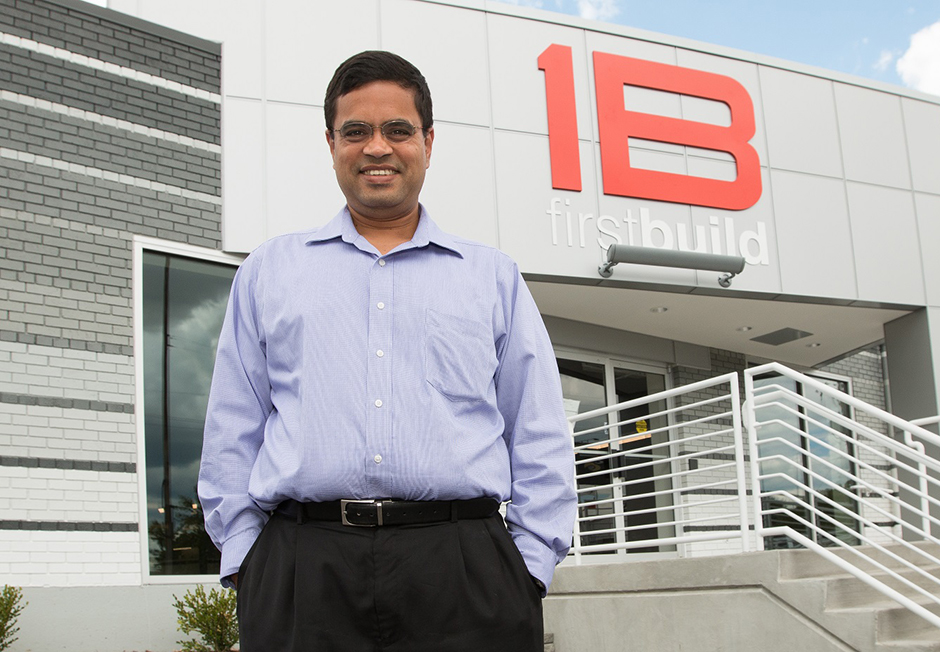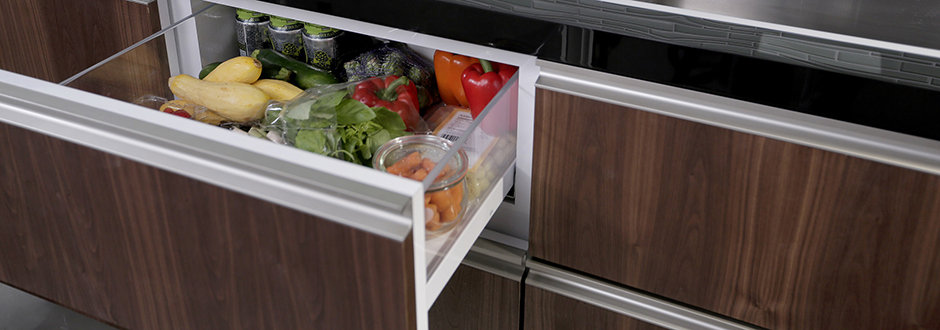Community is Key to Co-Creation
Collaboration supports clever designs of plastics-heavy appliances
Previous Article Next Article
By Robert Grace
Community is Key to Co-Creation
Collaboration supports clever designs of plastics-heavy appliances
Previous Article Next Article
By Robert Grace
Community is Key to Co-Creation
Collaboration supports clever designs of plastics-heavy appliances
Previous Article Next Article
By Robert Grace

Natarajan Venkatakrishnan, from GE Appliances, and director of FirstBuild (this photo and other images in this article are courtesy of GE).

Inside the GE/FirstBuild ChillHub refrigerator, showing Milky Weigh, a mobile milk-jug monitoring system.

GE Appliances’ Micro Kitchen, co-created through FirstBuild, was given a Gold IDEA (International Design Excellence Award) at August’s Industrial Designers Society of America conference.


The countertop Opal Nugget Ice Maker, another project designed by GE/FirstBuild.
It may have seemed like a fun social experiment to some. But to GE Appliances, it’s serious business. And a little more than a year after it launched its first “global co-creation community”—dubbed FirstBuild—the appliance maker has learned valuable lessons and reaped useful dividends. Others would do well to take notice.
The 12,000-employee GE Appliances, which is in the process of being acquired by Sweden’s AB Electrolux for $3.3 billion, describes FirstBuild as “a physical and online community dedicated to conceiving, designing, engineering, and building the next generation of major home appliances.” Its goal is to foster co-creation among engineers, designers, makers, and home enthusiasts worldwide by enabling them to participate in the development of products that people actually want.
Two of the project’s leaders spoke about its progress and challenges during an August telephone interview from their company headquarters at Appliance Park in Louisville, Kentucky, USA. Natarajan Venkatakrishnan, a 17-year GE veteran known as Venkat, is R&D director for GE Appliances and director of FirstBuild, and Lou Lenzi is director of industrial design operations for GE Appliances & Lighting.
Small-Batch Production, Quick to Market
The well-publicized venture—born out of a partnership between open-source hardware innovator Local Motors and GE Appliances—also includes a 33,000-square-foot (3,100 m2) “microfactory.” Its purpose is to enable customization through small-batch production, while helping to get the products to market faster than ever before without the cost and risk of traditional mass manufacturing.
Launched in late July 2014, FirstBuild in its first year gained 7,500 online community members, generated more than 800 product ideas, and launched eight new products. As regards FirstBuild’s current financial situation, a company official said: “Sales are increasing with the launch of additional products. We are on the path to breaking even.”
Venkat added: “We expect in the future to do a product a month.” The aim is to take an idea—regardless of where the concept originated from—do open development of it, and take the product to market in four to six months.
“What I find interesting is the scope of the products being developed,” noted Lenzi. “Last January at the Consumer Electronics Show we launched a $3,000 refrigerator, and just last week we launched an under-$500 countertop appliance. So it’s an opportunity to learn in a variety of price points and product types rather quickly.”
The refrigerator—called ChillHub—has two integrated USB hubs (eight USB ports in total), built-in wi-fi connectivity, and an open-source iOS app that allows users access to sensor data and control of the refrigerator’s components. GE claims “this is a first-of-its-kind platform that enables the development of new hardware products that can operate inside a cooled space.” About four were sold at the original price, but the community indicated it wanted a lower-priced model, so the co-creators quickly developed a $799 model.
But, Venkat noted, the ChillHub is not really for the retail market. It’s primarily an open-source development platform, he said, designed for makers, hackers, tinkerers, and developers to come up with their own accessories and apps.
For example, the first ChillHub accessory, Milky Weigh, was a mobile milk-jug monitoring system that provides real-time updates on how much milk is left. The team used an injection molded, flame-resistant PVC for the refrigerator control housing. The Milky Weigh, meanwhile, was 3-D printed using both a standard ABS and a biocompatible FDA-grade ABS for areas with potential food contact.
More recently, the FirstBuild community created the countertop Opal Nugget Ice Maker for home use. Online surveys revealed that consumers prefer soft, chewable nugget ice over crescent ice by a four-to-one margin. The new appliance can make ice at a rate of one pound (0.45 kg) per hour. Prototype parts—including the enclosure, the funnel/chute, and the water reservoir—were 3-D printed in ABS and acrylic, GE said, while longer term, the ABS components will be injection molded from PC/ABS.
FirstBuild launched a crowdfunding campaign for it on the website Indiegogo on July 28. At a launch price of $399, it quickly surpassed its funding goal of $150,000 and raised $2.5 million in sales during the highly successful campaign, which ended Aug. 26. The product will ship to early backers in mid-2016.
FirstBuild’s approach means “we are able to take a product to market quicker, and, more importantly, we are able to change a lot,” Venkat said.
Its Micro Kitchen concept, for example, aims to create a fully functioning kitchen in a 6-foot by 25-inch (1.8-m by 0.6-m) footprint for use in very compact urban spaces. Last summer FirstBuild solicited kitchen designs as part of a global
competition, and a panel of judges selected five designs submitted by individuals from four countries. FirstBuild then incorporated elements of each of the designs into Micro Kitchen prototypes that it plans to manufacture and sell for prices ranging from $7,000 to $15,000, depending on the configuration. And, working with the kitchen builder, it’s also able to take feedback and implement it immediately.
Lessons Learned
Despite strong global feedback and international interest, FirstBuild has opted to focus on creating products solely for U.S. and Canadian markets, due to issues related to voltages and lengthy customs approvals needed to sell overseas.
So what are some of the key lessons learned so far? “The power of the team,” says Lenzi. “These guys walk the talk about collaboration and openness and exchange of ideas … and there’s an underlying passion about that. I think a lot of companies could benefit from that culture.”
“What we are learning,” Venkat added, “is that there’s a big gap between consumers having an opinion and telling you what they want, and actually writing a check. Designers intuitively know that. But I don’t think the manufacturing guys know that, or the engineers know that. Once you have that mindset, I think you do much better products.”
And what have proven to be the biggest challenges to date? “We’ve gotten very good at developing the concepts,” Lenzi said. “One area we have yet to really leverage is the sales and distribution side.” This has been a tough transition for a firm whose traditional customers are the brick-and-mortar DIY stores, like Home Depot and Lowe’s.
“If we can crack into that lead user, we’ll really take this thing to a new level,” Lenzi said. “We need to tap into those people who want to adopt these innovations.”
“The sales channel has been difficult,” Venkat admitted. “These are larger products—$800 to $2,000 products—and we haven’t cracked the code about how consumers will buy a product like this without touching and feeling it. It’s very expensive to find early adopters online and sell to them. FirstBuild is not set up for the mass market—it’s just for early adopter[s] and new concepts.”
“Fail Fast, Fail Cheaply, Fail Forward”
FirstBuild is teeming with new product ideas. As shown at its website (firstbuild.com/explore), there are concepts such as an indoor Home Pizza Oven that cooks at over 300°C, or a device that allows users to roast their own coffee beans.
Of course, not all seemingly good ideas succeed. Take, for example, one of FirstBuild’s very first products—an auto-fill water pitcher that tapped into a water line in the refrigerator and refilled the pitcher automatically.
“The hypothesis was to make it a hacker kit,” explained Venkat. “Anyone who was interested could buy this kit and install it themselves, and they’ll have an auto-filling water pitcher. We made twelve of them, and we sold about four. We were all passionate, and we thought we’d sell hundreds of thousands of them … If we’d done tooling and we’d scaled up to make them, it would have been a big mistake.”
“Somebody would have lost their job,” added Lenzi. Thus another key FirstBuild lesson: Fail fast, fail cheaply, fail forward, and move on to the next great idea.
About the author… A 35-year B2B media veteran, Robert Grace was the founding editor of Crain’s Plastics News. An ardent design advocate, he left Crain in 2014 to found RC Grace LLC (www.rcgrace.com), a business consultancy that helps companies find business partners and enhance their market presence.
